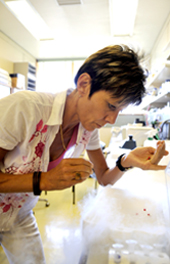Plant physiologists goes gold
29 July 2010 | Story by Newsroom Going gold: Prof Jill Farrant with the gold medal that came with her Harry Oppenheimer Fellowship Award, which will fund her work on resurrection plants like Xerophyta humilis, here displaying it various stages.
Going gold: Prof Jill Farrant with the gold medal that came with her Harry Oppenheimer Fellowship Award, which will fund her work on resurrection plants like Xerophyta humilis, here displaying it various stages.
If water stress is the Achilles' heel of agriculture and climate change is just tightening the screws, it's a good thing that scientists like Professor Jill Farrant are "working on the right thing at the right time".
The right thing, says Farrant, holder of a research chair in plant molecular physiology in UCT's Department of Molecular and Cellular Biology, is a species of plants known as 'resurrection plants', so called because they can withstand prolonged periods of near-total water loss by appearing to die. But, at the drop of a few precious drops of precious H2O, they spring back to life.
For some years, Farrant has dedicated herself to finding out how these plants are able to play possum like this. And if she can coax other plants - and crops - to do the same.
That work received a timely boost - other funds were drying up - when Farrant was recently named as the winner of the prestigious Harry Oppenheimer Fellowship Award for 2009, which supports work that advances knowledge, teaching, research and development in South Africa. The generous €100 000 purse (around R950 000) - and an eye-catching gold medal - that comes with award will go a long way to keep Farrant and her small squad of postgraduates in plants and pipettes.
All the way to the labs of some leading scientists in Switzerland and Italy, in fact. At the Institute of Plant Biology at the University of Zurich, Farrant has spent time with "old-school perfectionist" Professor Felix Keller, who will now help her pinpoint the exact roles played by the sucrose and the raffinose family oligosaccharides (sugars) that protect the plants in their wilted states, and then fuel their recovery when they rehydrate.
Later, she'll join Dr Francesco Loreto of the National Research Council in Rome. Loreto has the technology that allows him to identify, even in infinitesimal traces, a group of molecules known as lipids, which include fats and waxes. It's been found that these lipids play a key role in what's known as lipid-based signalling pathways, triggered by stress signals like drought. Farrant wants to unpack these pathways, which likely switch on the dormant genes that make resurrection plants so drought-tolerant.
While she's not opposed to the genetic modification of crops, she believes that these triggers and pathways and genes offer a more "natural" way to protect crops. "All crops have these genes," says Farrant. "They just never switch them on." It's the mechanisms used by resurrection plants, including the ones she's discovered on Table Mountain, that Farrant wants to tease out of other plants and crops.
Like Eragrostis tef, a tiny but high-protein seed that forms the basis for breads and cereals in Ethiopia and Eritrea, and is also digestible by the growing number of people with gluten intolerance. Tef is closely related to the resurrection grass Eragrostis nindensis, so screams for scrutiny.
"For me, to make a drought-tolerant crop out of tef, is a priority," says Farrant. "It's got to happen."
 This work is licensed under a Creative Commons Attribution-NoDerivatives 4.0 International License.
This work is licensed under a Creative Commons Attribution-NoDerivatives 4.0 International License.
Please view the republishing articles page for more information.










